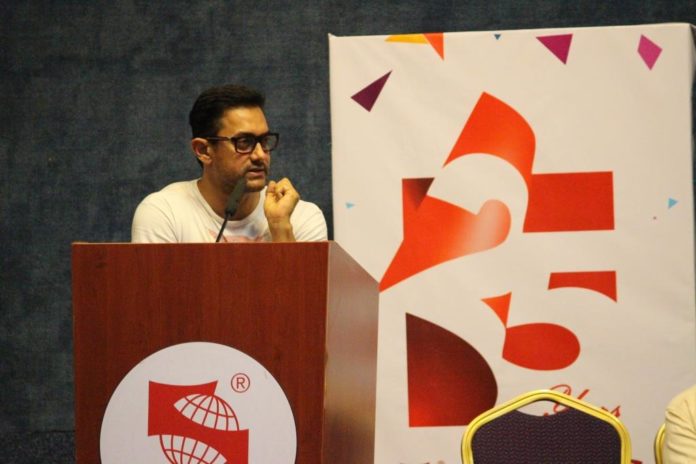Symbiosis Institute of Media & Communication (SIMC-PG), as a part of its silver jubilee celebrations, hosted an event on August 19, 2016, titled ‘Evolution of Media and Cinema’, which enlightened the audience on the journey of media post liberalisation, and presented them with a vibrant picture of the evolution of regional cinema in India. To the surprise of the esteemed guests and the audience, the gathering was graced with the presence of none other than the perfectionist of Bollywood, Mr Aamir Khan, accompanied by debutants Fatima Sana Shaikh and Sanya Malhotra.
The event was addressed by several stalwarts of the industry, including Kumar Ketkar, former editor, Loksatta, who was also the chief guest; Dileep Padgaonkar, Chair Professor, Faculty of Design, Media and Communications. The second half saw notable personalities of the film industry, including Ajay and Atul Gogavale, current sensations of the music industry, popularly known as the Sairat brothers, along with Jahnu Barua, the National Award winning film director from Assam; renowned film academician S.V. Srinivas; actress and theater artist Vibhawari Deshpande; Nishant Roy Bombarde, SIMC alumnus, and National Award winner for his debut film Daarvatha and an executive producer of movies such as Sairat, Fandry and Natasamrat.
The first half of the day witnessed a discussion on the topic ‘25 years of Indian Media Post Liberalization’ by the chief guest, Kumar Ketkar, veteran journalist and former editor, Loksatta. The inaugurating address of the event was delivered by Dileep Padgaonkar, who shed light on the changes that have happened in the ways news is being presented before the audience. He also emphasised on how the contemporary scenario offers the possibility of customization of news to its viewers. He propounded, “All news is in fact reflective of our own inhibitions, isolation and need to connect. It is the sense of being connected to something deep within us.”
Post lunch, there was a panel discussion on the ‘Evolution of Regional Cinema’, where a host of speakers explored the different facets of Indian regional cinema and its position vis-a-vis the Indian audience.

The excitement of the audience reached its peak when Aamir Khan made a surprise guest appearance and addressed them on how the Marathi film industry has reached milestones with films like Natasamrat and Sairat. Recalling his own experience of learning Marathi, Aamir Khan said, “Mr Suhas Limaye, my Marathi teacher, told me how languages hold culture and emotions and geography. It’s amazing that we have a country that makes movies in all these different languages. Tamil, Telugu and Kannada have always been vibrant languages. But the kind of films you make is relevant, not the language. Cinema has got no language.” In his opinion, a film is a reflection of what the director wants to communicate.
Sanya Malhotra and Fatima Shaikh, who play Aamir Khan’s daughters in the upcoming sports biopic Dangal, spoke about their experience of shooting for their first film, which required them to undergo rigorous training for both wrestling and Haryanvi. The former mentioned that the students of SIMC are fortunate enough to have such interactions with eminent personalities from the industry.
Jahnu Barua emphasized the point that whoever has coined the term regional cinema has done great damage to the country as he opined, “Whichever film represents India is a national film. To have such a demarcation is wrong.”
The Sairat musical duo established an instant rapport with the audience and mesmerized them with the soulful renditions of their own compositions. Highly inspired by their idol IIlayaraja, the duo revealed their philosophy of feeling music rather than blindly composing for any movie. They continued, “We have never learnt anything, we have only felt music. Kuch lines sunke aapko naachne ka mann karta hai, aur kuch ko sunte hi aapke rongtein khade ho jate hain. We have learnt all of this from feeling.”
Looking at the current scenario, Srinivas mentioned that regional cinema now has opportunities like never before, since single screens have been digitized and therefore there are more screens playing the same film on the same day. Along with the increased accessibility through internet, subtitles and dubbing further contribute in overcoming the linguistic barriers.
Nishant Roy Bombarde, an alumnus of SIMC, opined that Marathi cinema focuses on content, instead of stars. He also expressed the importance of academics as a career in this domain and therefore advised the students saying, “Academics will help you know beforehand what is going to happen. If you know the things theoretically you just have to connect the dots.”
Offering several insightful perspectives, the event was successful in giving the students a detailed acumen of the journey of Indian Media post liberalisation and the growth of Regional Cinema over the last two decades. The students were overwhelmed with Aamir Khan and his team’s presence at the event. Nupur Kedia, a second year MBA student, said, “The very first movie I saw was Raja Hindustani when I was 3 years old, and ever since I’ve been a huge fan of Aamir Khan. The session was enriching, but seeing him today made my day.”







